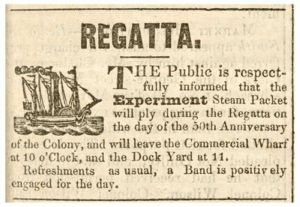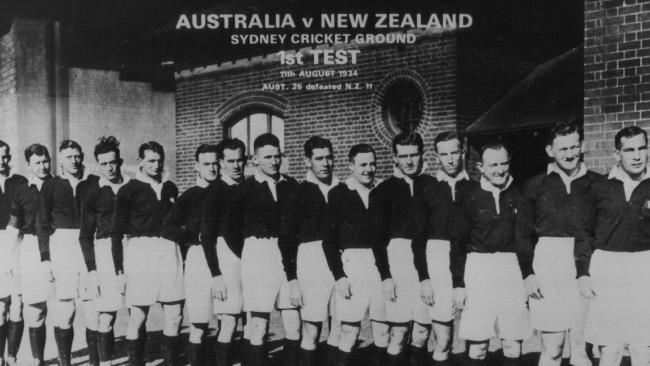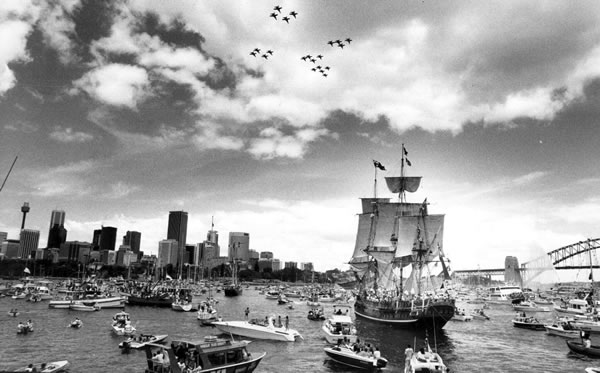|
Australian Fifty-cent Coin
The twelve-sided Australian fifty-cent coin is the third-highest denomination coin of the Australian dollar and the largest in terms of size in circulation. It is equal in size and shape to the Cook Island $5 coin, and both remain the only 12-sided coins in the southern hemisphere. It was introduced in 1969 to replace the round fifty-cent coin issued in 1966. The original, round, 50-cent coin was made of 80% silver and 20% copper; but as the value of a free-floating silver price became higher, the coin's bullion value became more valuable than its face value; so that version was withdrawn from circulation and replaced with the dodecagonal cupro-nickel version. It is by diameter the largest Australian coin currently issued and second largest after the Crown of 1937–38. It is also the heaviest Australian coin in common circulation. Many commemorative designs have been issued, the large size allowing for detailed content. With a diameter of 31.65 mm (1.25 in) a ... [...More Info...] [...Related Items...] OR: [Wikipedia] [Google] [Baidu] |
Australian Dollar
The Australian dollar (sign: $; code: AUD) is the currency of Australia, including its external territories: Christmas Island, Cocos (Keeling) Islands, and Norfolk Island. It is officially used as currency by three independent Pacific Island states: Kiribati, Nauru, and Tuvalu. It is legal tender in Australia.''Reserve Bank Act 1959'', s.36(1) an ''Currency Act 1965'', s.16 Within Australia, it is almost always abbreviated with the ($), with A$ or AU$ sometimes used to distinguish it from other |
Raphael Maklouf
Raphael David Maklouf (born 10 December 1937) is a British sculpture, sculptor, best known for designing an effigy of Elizabeth II of the United Kingdom, Queen Elizabeth II used on the coins of many Commonwealth of Nations, Commonwealth nations. Maklouf was born in Jerusalem, to a Jewish family; his father was Samuel Maklouf (1911–1990, born in Safed, then in Palestine); his mother was Leonie Maklouf (born in Saarbrücken, Germany, 1915). The family emigrated to the United Kingdom after the World War II, Second World War. Raphael Maklouf attended the Camberwell School of Art until 1958, afterwards becoming an academic lecturer for ten years. He was made an Associate of the Royal Society of British Sculptors in 1979. Two of his designs were selected for British coinage on 8 August 1984, one for general circulation and another for commemorative issues. They were used on the coins of several countries from 1985 to 1997. His initials, RDM, are engraved at the base of the Queen's ... [...More Info...] [...Related Items...] OR: [Wikipedia] [Google] [Baidu] |
Australian 50 Cent Coin (round)
The round fifty cent coin was the highest-denomination and largest diameter coin of the Australian decimal coins, introduced in 1966. It has a nominal value of half an Australian dollar, the equivalent of five shilling The shilling is a historical coin, and the name of a unit of modern currencies formerly used in the United Kingdom, Australia, New Zealand, other British Commonwealth countries and Ireland, where they were generally equivalent to 12 pence o ...s in pre-decimal currency. Due to the large number minted in 1966, and the rising cost of silver, it was not made in any other year. It was replaced by a twelve-sided 50 cent coin in 1969, which retained its reverse of the Australian Coat of Arms. The round fifty cent coin contained 80% silver and 20% copper but, because the value of silver quickly increased after the coins were issued, their bullion value became higher than their face value, so they were withdrawn from circulation. A total of 36.45 million coins were ... [...More Info...] [...Related Items...] OR: [Wikipedia] [Google] [Baidu] |
Coins Of The Australian Dollar
Coins of the Australian dollar were introduced on 14 February 1966, although they did not at that time include the one-dollar or two-dollar coins. The dollar was equivalent in value to 10 shillings (half a pound) in the former currency. Regular coinage Produced by the Royal Australian Mint, all current coins have featured four versions of the effigy of Her Majesty Elizabeth II, former Queen of Australia, on the obverse. The first effigy was designed by Arnold Machin, the second effigy by Raphael Maklouf, the third effigy by Ian Rank-Broadley and the fourth effigy by artist Jody Clark. They have all been matched with designs by the Australian-born artist Stuart Devlin on the reverse. The set now comprises a 50c, 20c, 10c and 5c coin, all still referred to as "silver", although they consist of 75% copper and 25% nickel. For many years there were also 2c and 1c coins, traditionally called "copper" coins, although they are actually an alloy of copper and zinc. The original 50 ... [...More Info...] [...Related Items...] OR: [Wikipedia] [Google] [Baidu] |
Mabo V Queensland (No 2)
''Mabo v Queensland (No 2)'' (commonly known as ''Mabo'') is a decision of the High Court of Australia, decided on 3 June 1992.. It is a landmark case, brought by Eddie Mabo against the State of Queensland. The case is notable for first recognising the pre-colonial land interests of Indigenous Australians within Australia's common law.e.g. in ''Milirrpum v Nabalco Pty Ltd'' ''Mabo'' is of great legal, historical, and political importance to Aboriginal and Torres Strait Islander Australians. The decision rejected the notion that Australia was terra nullius at the time of British settlement, and recognised that Indigenous rights to land existed by virtue of traditional customs and laws and these rights had never been wholly been lost upon colonisation. The Prime Minister Paul Keating praised the decision, saying it "establishes a fundamental truth, and lays the basis for justice". Conversely, the decision was criticised by the government of Western Australia and various minin ... [...More Info...] [...Related Items...] OR: [Wikipedia] [Google] [Baidu] |
1967 Referendum
The 1967 Australian referendum occurred on 27 May 1967 under the Holt Government. It contained three topics asked about in two questions, regarding the passage of two bills to alter the Australian Constitution. The first question (''Constitution Alteration (Parliament) Bill 1967'') sought to increase the number of Members in the House of Representatives. The second question (''Constitution Alteration (Aboriginals) Bill 1967'') related to Indigenous Australians (referred to as "the Aboriginal Race") and was in two parts: whether to give the Federal Government the power to make laws for Indigenous Australians in states, and whether in population counts for constitutional purposes to include all Indigenous Australians. Results in detail Parliament :''This section is an excerpt from 1967 Australian referendum (Parliament) § Results'' Aboriginal people :''This section is an excerpt from 1967 Australian referendum (Aboriginals) § Results'' See also *Referendums in Australia ... [...More Info...] [...Related Items...] OR: [Wikipedia] [Google] [Baidu] |
Australian Institute Of Aboriginal And Torres Strait Islander Studies
The Australian Institute of Aboriginal and Torres Strait Islander Studies (AIATSIS), established as the Australian Institute of Aboriginal Studies (AIAS) in 1964, is an independent Australian Government statutory authority. It is a collecting, publishing and research institute and is considered to be Australia's premier resource for information about the cultures and societies of Aboriginal and Torres Strait Islander peoples. The institute is a leader in ethical research and the handling of culturally sensitive material'Aboriginal and Torres Strait Islander Library, Information and Resource Network (ATSILIRN) Protocols for Libraries, Archives and Information Services', http://atsilirn.aiatsis.gov.au/protocols.php, retrieved 12 March 2015‘'AIATSIS Collection Development Policy 2013 – 2016'’, AIATSIS website, http://aiatsis.gov.au/sites/default/files/docs/about-us/collection-development-policy.pdf, retrieved 12 March 2015 and holds in its collections many unique and irrepla ... [...More Info...] [...Related Items...] OR: [Wikipedia] [Google] [Baidu] |
Australia Day
Australia Day is the official national day of Australia. Observed annually on 26 January, it marks the 1788 landing of the First Fleet at Sydney Cove and raising of the Union Flag by Arthur Phillip following days of exploration of Port Jackson in New South Wales. In present-day Australia, celebrations aim to reflect the diverse society and landscape of the nation and are marked by community and family events, reflections on Australian history, official community awards and citizenship ceremonies welcoming new members of the Australian community. The meaning and significance of Australia Day has evolved and been contested over time, and not all states have celebrated the same date as their date of historical significance. The date of 26 January 1788 marked the proclamation of British sovereignty over the eastern seaboard of Australia (then known as New Holland). Although it was not known as Australia Day until over a century later, records of celebrations on 26 January dat ... [...More Info...] [...Related Items...] OR: [Wikipedia] [Google] [Baidu] |
Edward Dunlop
Colonel Sir Ernest Edward "Weary" Dunlop, (12 July 1907 – 2 July 1993) was an Australian surgeon who was renowned for his leadership while being held prisoner by the Japanese during World War II. Early life and family Dunlop was born in Wangaratta, Victoria, the second of two children of parents James and Alice. He attended Benalla High School for two years of his education. He started an apprenticeship in pharmacy when he finished school, and moved to Melbourne in 1927. There, he studied at the Victorian College of Pharmacy and then the University of Melbourne, where he obtained a scholarship in medicine. Dunlop graduated from the University of Melbourne in 1934 with first class honours in pharmacy and in medicine, and excelled as a sportsman at Melbourne University and Ormond College. The nickname "Weary" was a reference to his last name—"tired" like a Dunlop tyre. Rugby union career Although brought up playing Australian Rules football, when at university – and alt ... [...More Info...] [...Related Items...] OR: [Wikipedia] [Google] [Baidu] |
International Year Of The Family
The year 1994 was proclaimed the International Year of the Family by the United Nations General Assembly. Its objectives are promoted by the United Nations Programme on the Family. This was one of many International observances declared for specific days, months and years. In October 1994, the United Nations Secretary-General The secretary-general of the United Nations (UNSG or SG) is the chief administrative officer of the United Nations and head of the United Nations Secretariat, one of the six principal organs of the United Nations. The role of the secretary-g ... opened the three-day International Conference on Families, saying: References External links {{Authority control Family, International Year of the Family 1994 in the United Nations ... [...More Info...] [...Related Items...] OR: [Wikipedia] [Google] [Baidu] |
Australian Bicentenary
The bicentenary of Australia was celebrated in 1988. It marked 200 years since the arrival of the First Fleet of British convict ships at Sydney in 1788. History The bicentennial year marked Captain Arthur Phillip's arrival with the 11 ships of the First Fleet in Sydney Harbour in 1788, and the founding of the city of Sydney and the colony of New South Wales. 1988 is considered the official bicentenary year of the founding of Australia. Celebrations The Australian Bicentenary was marked by pomp and ceremony across Australia to mark the anniversary of the arrival of the First Fleet of British ships at Sydney in 1788. The Australian Bicentennial Authority (ABA), pursuant to the Australian Bicentennial Authority Act 1980, was set up to plan, fund and coordinate projects that emphasized the nation's cultural heritage. State Councils were also created to ensure cooperation between the federal and state governments. The result was a national programme of events and celebrations ... [...More Info...] [...Related Items...] OR: [Wikipedia] [Google] [Baidu] |
1982 Commonwealth Games
The 1982 Commonwealth Games were held in Brisbane, Australia, from 30 September to 9 October 1982. The Opening Ceremony was held at the QEII Stadium (named after Elizabeth II), in the Brisbane suburb of Nathan. The QEII Stadium was also the athletics and archery events venue. Other events were held at the purpose-built Sleeman Sports Complex in Chandler. The Chairman of the 1982 Commonwealth Games was Sir Edward Williams. The 1982 Commonwealth Games Logo was designed by Hugh Edwards, who was the winner of a nationwide competition held in 1978. The symbol is derived from the form of a bounding kangaroo. The three bands, forming stylized A's (for Australia), are in colours which are common to flags of many Commonwealth countries. The mascot for the games was a cartoon kangaroo called Matilda. A 13-metre-high (42.65 feet) mechanical kangaroo travelled around the stadium and winked at the crowd. The games were officially opened by The Duke of Edinburgh and closed by Elizabet ... [...More Info...] [...Related Items...] OR: [Wikipedia] [Google] [Baidu] |

.png)


